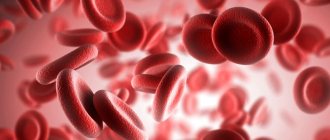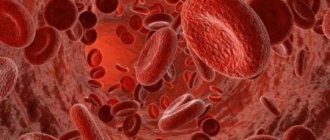Plasma cells belong to a group of white blood cells whose main task is to destroy pathogenic microorganisms that enter the body. Plasmocytes have one unique feature that makes them so valuable to the body. They are able to synthesize specific antibodies, that is, they adapt to the type and type of causative agent of the inflammatory process, while increasing the chances of a person’s rapid recovery. These cells also have memory, which helps the immune system “remember” bacteria and viruses and eliminate them as quickly as possible when they re-enter the body. We will consider further what number of plasma cells a blood test should contain, and in which case deviations from the norm are diagnosed.
Plasmocytes have a round or oval shape , and their size does not exceed 16 microns. They are an integral part of the immune system, helping to prevent the spread of pathogenic microflora that enters the body from the outside.
These cells are synthesized from B lymphocytes, which allows them to recognize the antigen and produce immunoglobulins that interfere with its activity.
The lifespan of mature cells is short - only 2-3 days. But the body always has a reserve necessary for constant control. This reserve is located in the lymph nodes, spleen, and also red cells of the bone marrow, so in any situation, plasma cells are ready to attack and stand guard over health.
The appearance of plasma cells in the blood indicates that there is an active fight against pathogenic microorganisms that have entered from the outside. In other words, plasma cells are the body’s natural defense reaction to a pathogen. If they are absent in the body, it can be said that the person is completely healthy and is not susceptible to attacks by viruses and bacteria.
Emergence process
Let's consider a scheme in which a large number of plasma cells enter the blood. The initial stage is the entry and activation of pathogenic bacteria in the body. In this case, natural defenses are immediately triggered, and immune cells signal the presence of a “stranger” who can pose a clear threat.
The brain gives a signal about the need to produce plasma cells, so the active transformation of B lymphocytes into plasma cells begins in the lymph nodes.
While this process occurs, the bacterium can multiply and adapt to environmental conditions. Therefore, the synthesis of plasma cells occurs continuously in order to prevent a full-scale inflammatory process. In the quantitative composition of the blood, in the presence of inflammation, a large number of plasma cells will be visualized, which indicates the presence of activation of the immune system.
In the process of destroying pathogenic cells, plasma cells, in addition to immunoglobulins, produce memory cells. They help to recognize bacteria and viruses, after which their re-entry into the body will be eliminated faster. The immunization system is based on this property of immunity, when children are injected with a small amount of pathogenic microorganisms that are causative agents of dangerous diseases, after which the immune system is able to independently overcome the infection and remember the “enemy in the face.” There is no need to expend precious time and energy on antigen recognition, so cells can go into battle immediately after encountering an enemy. Accordingly, if the same cells enter the body a second time, the immune system will work faster and the person will experience less stress.
The appearance of plasma cells in the child’s blood
Lymphocytes are converted into plasma cells if the body is under threat. When an antigen penetrates it, a signal is sent to the brain warning of danger. Group B lymphocytes, essential for the formation of immunity, are concentrated in the lymph nodes, activated, and later converted into plasma cells.
It turns out that plasma cells are transformed B-lymphocytes, some of which become active, which is a necessary condition for eliminating the threat to health:
- Some produce antibodies that fight the harmful agent;
- Others turn into memory cells. They are necessary if the same antigen enters the body again. Then they give a signal, and the fight against the dangerous substance begins. Immune memory works for months or many years. Sometimes it persists until the end of life. The plasma cells themselves die quite quickly; after 2-3 days they are not detected in the blood.
Causes
The appearance of plasma cells in the blood is a natural process in the body that develops in the presence of a threat to life. These cells are constantly present in the body, forming immunity. At the right moment, when pathogenic microorganisms are parasitizing, plasma cells are activated and prevent the development of the inflammatory process.
Thus, the presence of plasma cells in the blood indicates progressive inflammation in the body, and the degree of excess of the norm shows how full-scale the infection is.
What does their presence indicate?
When plasma cells are detected in a blood test, this indicates the presence of an inflammatory process in the body. Most often, high rates are characteristic of the progression of diseases such as:
- Acute respiratory infections and acute respiratory viral infections, especially if treatment was not started in a timely manner.
- Bacterial infections that can be chronic and sometimes worsen.
- Autoimmune diseases, in which there is a malfunction in the immune processes, which as a result leads to uncontrolled attacks by plasma cells on their own cells, perceived as foreign.
- Chicken pox and mononucleosis, after fighting the pathogen, immunity is formed.
- Oncological neoplasms that place additional stress on the immune system.
It is extremely rare that an increase in plasma cells in the blood occurs asymptomatically.
Typically, a person initially experiences a high fever, chills, sore throat, or body aches, after which a blood test shows high levels of these cells.
Also, high levels can persist for another 2-3 days after the acute clinical picture disappears, which indicates the need to maintain immunity and an increased content of immune cells.
Increase in plasma cells
Detection of plasma cells in a child’s blood above the established norm may indicate the development of one of the following diseases:
- Viral infection, for example, measles, rubella, chickenpox, mononucleosis;
- Autoimmune disorders;
- Tuberculosis;
- Streptococcal infections. They represent a group of pathologies; it is not always possible to immediately determine the cause of the ailment. Scarlet fever is caused only by streptococci, so at the first sign the doctor prescribes the necessary antibiotics. With inflammatory processes in the throat, it is impossible to find out from a blood test what exactly triggered the disease. Most often, children have streptococcal tonsillitis;
- Staphylococcal infections. As a result of the bacteria entering the body, a number of symptoms appear, in particular, diarrhea, nausea and vomiting. The child becomes lethargic and refuses to eat. Staphylococcus can affect the mouth, throat, skin, and genitourinary system;
- Flu;
- Fungal infections;
- ARVI.
The higher the indicator value, the more dangerous the pathological process. Only a doctor can determine the reason for the increase. He will evaluate all the indicators in the resulting analysis together, examine the child; his well-being and the presence of additional symptoms are of great importance. If this is not enough to make a diagnosis, the necessary additional studies will be carried out.
Note! Most often, plasma cells grow in children during colds, as well as viral infections that children usually suffer from: measles, rubella and chickenpox.
Chickenpox in a child
The reading may remain elevated for several days. Even after complete recovery, cells may be visible in a blood test. They quickly die and everything returns to normal. If, during a retake, a high value of the studied indicator is again observed, this indicates pathology.
In children, immunity is just developing, constantly encountering various infections. That is why a slight presence of plasma cells in the blood is considered normal. They can also appear after vaccination, this indicates that immune protection has appeared and will begin to work when a threat to the body arises. Therefore, when 1 or 2 plasma cells out of 400 others are found in a child’s blood, this does not mean that a pathological process is taking place. You just need to undergo an examination after a few days to make sure that the value of the indicator does not increase.
What values are considered normal?
should not have plasma cells
in their blood
In children, the appearance of 2-3 plasma cells per 1000 remaining cells is allowed, which most often emerges during the period of immunization. If a blood test shows the presence of these cells, then it is necessary to carry out an additional examination and identify the true cause of their appearance.
The concentration of plasma cells in the blood is directly proportional to the development of the inflammatory process, that is, the more sick a person is, the more cells are visualized.
What analysis is it determined by?
In the case when a person feels unwell and clinical signs of a cold appear, a simple blood test , taken from a finger, is sufficient. To do this, a small puncture is made in the ring finger, after which blood is drawn onto a glass slide using a capillary. Next, the resulting sample is examined under a microscope, where the total number of blood cells is assessed, as well as the presence or absence of plasma cells. In cases where additional diagnostics are required, blood is taken from a vein and the exact number of plasma cells is detected using PCR or other reactions. Most often, a blood test from a finger prick is sufficient. The second diagnostic method is used when a person does not experience any symptoms, but the plasma cell count remains high.
How do plasma cells appear in the blood?
In a person without health problems, the number of plasma cells does not exceed two cells per thousand others. Therefore, when up to 200 cells are taken for analysis, they are often not diagnosed at all. For an infant, the normal level of plasma cells in the blood is 2%. Only an increase in the number of plasma cells is diagnosed, since a decrease in their number in the blood is not detected and does not cause health problems.
The most common type of diagnosis of plasma cells is a general blood test, during which various blood pathologies, causes of dizziness, increased body temperature, lethargy and increased fatigue are identified. Material for analysis is collected from a finger or vein.
You need to make sure that the patient has no symptoms of measles, meningitis, rubella, encephalitis, or leukemia. Timely therapy will allow you to get rid of many concomitant diseases. Often the number of plasma cells increases with infectious mononucleosis, which without proper treatment can lead to serious complications.
A blood test for plasma cells will help determine the progression of many infectious diseases, including cancer, which will allow timely treatment to begin and shorten the recovery period. With the right approach to examination, a qualified doctor will be able to easily determine the cause of the inflammatory process. A general blood test is an accessible and simple way to diagnose the level of plasma cells in the blood.
If it shows plasma cells, it means that you recently encountered a virus, bacteria, or there is an inflammatory process in the body. This information can be tracked even in a general blood test, and a competent therapist can easily determine the reason that could provoke the appearance of plasma cells in the body.
Do not think that plasma cells are foreign bacteria that have infected the body. Plasma cells are our body’s reaction to an external pathogen, but they are produced from B lymphocytes, which means they are constantly in the lymph nodes, red bone marrow and spleen. The main function of these organs is the production of antibodies, that is, immunoglobulins. The process looks something like this:
- When a pathological process develops in the body, the brain sends signals to places where B lymphocytes accumulate.
- After receiving a signal indicating a specific antigen, the B lymphocyte settles in the lymph nodes and begins to transform into a plasma cell, which is necessary to eliminate this type of problem.
- At the end of the transformation process, the plasma cell begins to synthesize antibodies to the specified antigen.
- Most plasma cells live for about 3-4 days before they die, but some enter a waiting phase. These plasma cells are concentrated in the human bone marrow. These memory cells are activated as soon as antigens of the same type enter the body again. The lifespan of such plasma cells can be 40-50 years. They provide resistance to some infectious diseases.
If plasma cells are elevated, additional tests should be taken and symptoms studied to establish a diagnosis. However, you shouldn’t worry too much - after suffering from a cold, for example, plasma cell counts persist for several days.
A general blood test does not require any special preparation from the patient. For the study to show the correct result, blood must be donated in the morning on an empty stomach. Test results can usually be obtained the next day.
After drawing blood, the laboratory technician counts the number of different cells under a microscope and also identifies plasma cells. The result must be deciphered by a doctor. The specialist will determine whether everything is normal and what treatment is necessary.
Detection of an increased number of plasma cells requires repeated analysis, and histology is performed if necessary.
https://www.youtube.com/watch?v=j_frN_NwA-Y
The analysis itself is virtually painless and does not take much time:
- To collect the material, the ring finger is punctured with a scarifier;
- the blood is collected in a special flask and applied to a glass slide;
- the number of cells is counted under a microscope;
- the result obtained is sent to the attending physician for decoding.
Blood test
The specialist, having determined the cause of the appearance of plasma cells, will prescribe the necessary course of treatment. Most often, simultaneously with a repeat examination, a comprehensive examination of the patient is prescribed to thoroughly identify the causes of deviations and find the right remedy to eliminate them.
A plasma blood test does not require careful preparation; it is enough to follow generally accepted rules. That is, you need to come to the laboratory in the morning and not eat before taking material for research. The blood substance is collected from a finger, by piercing it with a scarifier and taking a few drops using a flask.
If plasma cells are detected in the bloodstream, this is clearly a sign of a pathological process. The disease is either in an active stage at the moment in the body. Or plasma cells in a blood test indicate residual effects after an illness. Because plasma cells are not detected in a healthy person.
Plasma cells of the bloodstream in a blood test are normally found in the amount of one or two per thousand other shaped particles of the blood mass. The difference is observed only in newborns - in infants, the normal number of plasmacytes in the blood varies within 1-2% of the total number of other blood cells.
Dangers and Consequences
In the case when high levels of plasma cells in the blood are detected by chance during a routine examination and the person does not experience any health problems, there is a need for a more accurate examination.
The fact is that the cause may be autoimmune diseases and oncology, the initial stages of which are asymptomatic.
In the absence of a timely search for the cause of what is happening, there is a high probability that the disease will progress, reducing the chances of a full recovery. Therefore, even if there are no health complaints, but these cells appear in the blood, it is necessary to consult a doctor and find out why this happened and what the dynamics are. If plasma cells are not detected during a repeated blood test, then there is no need to worry. But when their number is growing rapidly, there is a need for a more detailed examination.
Plasma cell pathologies
There are a number of dangerous diseases that develop due to pathological processes in plasma cells. These include:
- Myeloma - plasma cells form tumors that destroy bone tissue (most often), and also have an increased impact on all vital organs and systems. The disease cannot be cured completely, since the nature of its occurrence is not fully understood. The person gradually dies, experiencing constant pain.
- Waldenström's macroglobulonemia is combined with lymphadenopathy. Therefore, it has an aggravated course and is considered incurable. The target organs are mainly bones, liver and spleen. The life expectancy of such patients does not exceed 3-5 years.
- Franklin's disease is a genetic disease in which malabsorption syndrome progresses. The person rapidly loses weight and also suffers from anemia. People over 25 years of age are at risk.
- Seligmann's disease is accompanied by a disruption of the immune system, which causes constant diarrhea, which causes a person to rapidly lose weight and not receive all vital nutrients.
What to do?
If a high level of plasma cells is detected in a general blood test, it is necessary to identify the cause . To do this, the doctor collects an anamnesis, after which he prescribes a number of mandatory tests to make the correct diagnosis. Self-medication in this case is inappropriate, since you need to know what to treat and how to treat it. And only a doctor has such knowledge.
Don't panic when thinking about cancer. High rates do not always indicate cancer.
This is how an infection or other disease can manifest itself, so before an accurate diagnosis is established, you should not suffer from guesswork and make diagnoses yourself, based on clinical manifestations.
Features in children
Komarovsky E.O. notes that plasma erythrocyte cells in the blood plasma of an adult do not correspond in number to the indicators of a child - they are lower.
Plasmocytes in a child’s blood test are part of leukocytes and make up a small number. To check the analysis result, a leukocyte formula table is used, in which plasma cells are distributed as follows:
- the first 24 hours of life they are not there at all;
- up to 5 days, 1-3 plasma flat cells in the child’s blood are normal;
- by 5 days and up to a year, no more than 0.5-1 should form;
- after one year to 15 years the amount reaches 0.5.
Cellular composition of plasma cells
When the percentage of white blood cells increases or decreases, the plasma cells in the child’s blood test generally remain within normal limits. A pathological change in their quantity can occur when:
- advanced purulent-inflammatory process;
- oncological process, including such results as plasmacytoma and leukemia;
- injuries and burns of a large area of the body;
- postoperative recovery period.
Prevention of the condition
There are no specific measures in medicine that could prevent the appearance of plasma cells in the blood. However, as mentioned above, high rates are directly related to the presence of an inflammatory process in the body, so the following recommendations can be used to prevent it:
- Complete medical examination and immunization in a timely manner.
- Improve your diet by giving up unhealthy foods and fast food in favor of healthy foods.
- To live an active lifestyle.
- Drink at least 1.5 liters of water per day, which will help improve metabolic processes.
- Spend more time outdoors.
- Support the body during cold periods with vitamin complexes.
Thus, if plasma cells are detected in a general blood test, then it is necessary to find out the cause .
For no reason, these immune cells cannot appear in the blood. Their presence indicates the presence of some antigen against which they are fighting. Also, the cause may be cancer and autoimmune diseases, the existence of which even the person himself does not know for a long time. Therefore, if these cells are present in the blood, you should not refuse additional research.
The normal number of plasma cells in a child’s blood
Plasma cell (plasmocyte)
- immobile or very weakly mobile, short-lived (2-3 days, according to other sources - up to 10-30 days) cell - the final stage of B-lymphocyte development. During differentiation from a B-lymphocyte, it loses receptors for the C3 component of complement, membrane immunoglobulins and MHC molecules, as well as CD19 and CD21 markers.
Function
plasma cells is to provide humoral immunity by producing antibodies.
In 1 second, each plasma cell synthesizes up to several thousand immunoglobulin molecules (more than 10 million molecules per hour). Plasma cells are able to switch from producing immunoglobulins of one class to another.
Switching the classes of immunoglobulins produced (isotype switching) occurs in developing plasma cells at approximately 1-day intervals - from IgM to IgC or IgA - without changing their antigen-binding site.
Plasma cells are not foreign elements in the body. They are produced from B lymphocytes and are constantly present in the lymph nodes, spleen, and red bone marrow. An important function of these organs is the production of such cells.
The process of formation of plasma cells occurs in several stages. When inflammation occurs, the brain sends a signal to the site of accumulation of B lymphocytes to begin fighting the infection.
The brain receives a signal which antigen has entered the body, and B lymphocytes are transformed into plasma cells. After this, plasma cells synthesize antibodies to the specified antigen.
Most plasma cells live no more than 3-4 days. But some cells do not die after the body has dealt with the infection, but go into a waiting phase. Such plasma cells accumulate in the bone marrow. If antigens of the same type enter the body again, these cells will be activated and quickly cope with the disease, because the body will not need to waste time recognizing the antigen. This creates immunity to certain infections.
The maximum lifespan of a plasma cell does not exceed 5 days. At the same time, memory cells are formed in which information about antigens is stored for up to 50 years. Their function, when danger arises, is to synthesize the desired type of antibodies until the pathogen is eliminated.
Plasma cells should not be detected in a general blood test in adults; they are extremely rare in children. Their presence may indicate infection or a recent illness.
An increase in plasma cells can be observed with a cold
If the detected red plasma cells in a child’s blood test are 1-3, then there is no cause for concern. The body itself can cope with the infection. The appearance of more of them in the blood plasma requires additional research, since plasma cells in a blood test indicate:
- oncological diseases;
- colds, bronchitis;
- autoimmune disorders;
- mononucleosis, dysbacteriosis;
- measles, rubella, encephalitis, meningitis and other pathologies.
The need for a general study is indicated by:
- increased body temperature;
- dizziness, weakness, nausea;
- fatigue, loss of performance.
The material for analysis is taken from a finger or from a vein in the morning on an empty stomach. For doctors, the first method is preferable. A person does not have to undergo special training before donating blood.
Plasma cells in the blood appear at the final stage of the formation of B lymphocytes. They are round or oval in shape and their diameter is about 16–19 microns. Plasmocytes are always present in the bone marrow, and a certain part of them is constantly located in the lymph nodes and spleen. The duration of their existence is from three to four days.
The procedure for the formation of plasma cells is carried out in several stages. The moment the brain receives a signal that an antigen has entered the body, the process of transformation of B-lymphocytes into plasma cells begins. And they, in turn, begin the emergency synthesis of antibodies to a specific type of pathogen that has entered the human body.
If plasma cells are detected in a general blood test, additional examination may be necessary. To identify the specific causative agent of a particular pathology, there are diagnostic methods with the maximum degree of reliability, such as PCR, ELISA and others.
The presence of plasma cells in a blood test indicates the following diseases:
- Influenza, acute respiratory diseases (ARI), acute viral respiratory infections (ARVI).
- Bacterial infections with staphylococcus, streptococcus and other pathogens.
- Septic lesions.
- Various types of infections.
- Autoimmune pathologies.
- Oncological diseases.
- Consequences of radiation.
- Plasmacytoma, mononucleosis, chicken pox, measles and others.
A clinical blood test for plasma cells is taken at the first symptoms of illness. Such signs include increased body temperature, dizziness or headache, aching joints and other eloquent indicators of the penetration of a bacterial or viral infection into the body. If at least one of the listed symptoms appears, it is necessary to establish the cause of the painful condition as soon as possible, especially when it comes to a child. Moreover, a blood test for plasma cells is a simple and accessible method of laboratory diagnosis.
The presence of plasma cells in a child's general blood test may cause concern for parents. It is important to remember that the opinion about the foreign origin of these cells is erroneous. Let's consider what they are, what they are intended for, how many of them are considered normal, and what measures need to be taken if their number according to the test results is exceeded.
The presence of several units of plasma cells in a child’s blood is considered normal. If no more than 1-2 plasma cells are detected per 1000 total blood cells, there is no cause for concern. The exception is infants - a value within 1-2% of the total number of cells is considered normal. A certain number of plasma cells are constantly present in the spleen, lymph nodes and bone marrow.
When conducting clinical studies, during which no more than 200 cells are selected, it is not possible to determine the quantitative indicator of plasma cells in the blood. For this, a general blood test is indicated.
The study is aimed only at counting the increased number of these cells, since the decrease does not in any way affect children's health. Blood is taken from a vein or from a finger (this procedure is cheaper and simpler, so it is used more often).
These cells are involved in the functioning of the immune system, which means their increased number indicates a progressive or past inflammatory process of a viral or infectious nature. It can be:
- acute purulent infection (sepsis);
- bacterial infections by pathogens such as streptococcus, staphylococcus and candida;
- radiation exposure;
- oncology;
- colds such as acute respiratory viral infections, acute respiratory infections, influenza;
- infectious diseases of various origins;
- tuberculosis, dysbacteriosis, serum sickness;
- autoimmune pathologies;
- multiple myeloma (plasmocytoma);
- measles, infectious mononucleosis, rubella or chickenpox (see also:).
After recovery, the increased content of plasma cells in the blood persists for several days, after which their number returns to normal. The child recently suffered from an illness - this is a possible reason for such test results.










